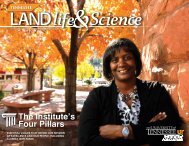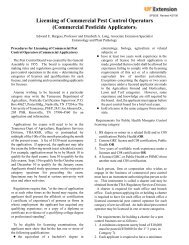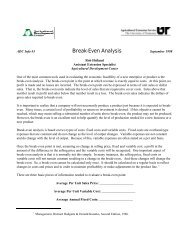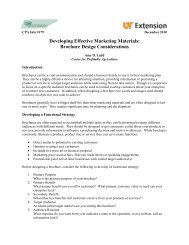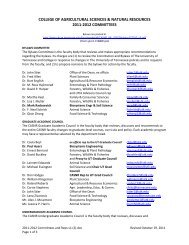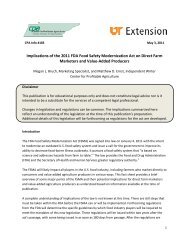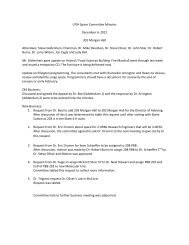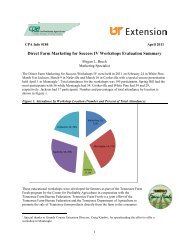Volume 8, Number 1 â Spring/Summer 2011 - The University of ...
Volume 8, Number 1 â Spring/Summer 2011 - The University of ...
Volume 8, Number 1 â Spring/Summer 2011 - The University of ...
You also want an ePaper? Increase the reach of your titles
YUMPU automatically turns print PDFs into web optimized ePapers that Google loves.
In pr<strong>of</strong>ile:Dr. Dan WardPhil SnowAs a veterinary student, Ward envisioned himselfteaching. In the blink <strong>of</strong> an eye, it became areality. <strong>The</strong> assistant department head in SmallAnimal Clinical Sciences didn’t go into teachingbecause he enjoyed ophthalmology—he wentinto ophthalmology so he could teach.After graduating and a twoyearstint in private practice,you set your sights on teachingand absolutely love it.Why?It’s intangible. Watching a student’sreaction, seeing that light bulb go onreally does it for me. I can start a classwith a room full <strong>of</strong> tired students whowould rather be anywhere at that particularmoment and 30 minutes intoclass it starts rocking—they’re yellingout answers and are excited aboutlearning. I’m having all this fun andat the same time I’m training tomorrow’sveterinarians.Ophthalmology wasn’t yourfirst love.No, teaching was first. When I was invet school (UTCVM ’85), we didn’thave an ophthalmologist (severalveterinary colleges still don’t), soI had very little exposure to it, butwhat I did have exposure to was reallygood teachers: Sims, Krahwinkel,Brace, Legendre, DeNovo, Gompf,Weigel, Dorn, Hopkins … all storiednames in teaching at UT, and allhad a tremendous influence on me.I was interested in farm animal, butthere weren’t any opportunities inthe teaching arena. So, I guess I did itbackwards. Veterinary ophthalmologistsdon’t typically go into academics,they go into private practice. I wantedto teach and found where there wereopportunities, and it turned out I likeophthalmology.What challenges do you faceteaching ophthalmology?Not to be “punny,” but it’s a very visualdiscipline. We diagnose and teachby sight. More animals equal moreopportunities to show the studentswhat corneal cholesterol, cataractsand ulcers are.What is your favoritesurgery?Cataract surgery never gets old. It is apretty surgery, resembling the goldencolors <strong>of</strong> galaxies in deep space. <strong>The</strong>technology has evolved to keep it exciting.I guess I’ve done a thousand orso cataract surgeries and it, along withcorneal reconstruction on horses, aremy favorite procedures. We’ve beenunbelievably blessed with a supportiveadministration. We’re using thebest operating scopes and cataractmachines on the market—not just inveterinary medicine, but in the marketperiod.You were able to tackle adream challenge in 2010.I’ve done four marathons and dozens<strong>of</strong> half marathons. Turning 50 lastyear prompted me to do somethingspecial. I’d had my sights on the NewYork Marathon for some time. <strong>The</strong>Multiple Sclerosis Society uses therace as a fundraiser, and since mywife has MS, I joined the MS team,being too slow to qualify on my own!Let’s just say one <strong>of</strong> the Chilean coalminers finished eight minutes ahead<strong>of</strong> me. But my group raised the thirdmost amount <strong>of</strong> money <strong>of</strong> any groupin the country for MS, almost $11,000.Besides teaching veterinarystudents, what makes yourjob rewarding?Our varied caseload. We work ondogs, cats, horses, raptors and theruminants that I call healing machines:cattle, sheep and goats. A dogcomes in blind from cataracts in themorning and that evening he can see.That’s gotten to be so commonplacethat we don’t think about it anymore,but I guess we should never take it forgranted. That’s a cool thing.19





